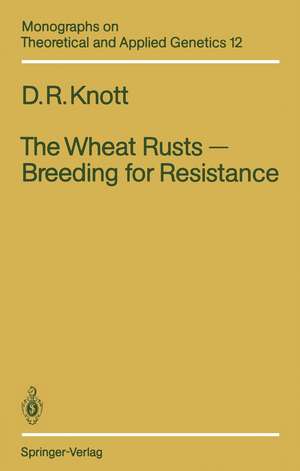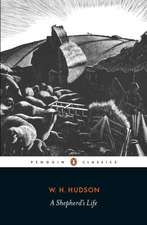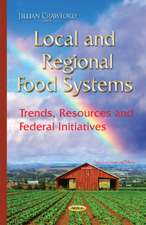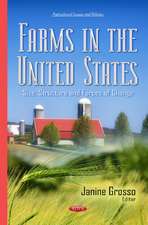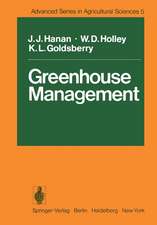The Wheat Rusts — Breeding for Resistance: Monographs on Theoretical and Applied Genetics, cartea 12
Autor Douglas R. Knotten Limba Engleză Paperback – 5 dec 2011
Din seria Monographs on Theoretical and Applied Genetics
- 20%
 Preț: 559.63 lei
Preț: 559.63 lei - 18%
 Preț: 985.38 lei
Preț: 985.38 lei -
 Preț: 383.71 lei
Preț: 383.71 lei - 15%
 Preț: 641.38 lei
Preț: 641.38 lei - 15%
 Preț: 644.30 lei
Preț: 644.30 lei - 15%
 Preț: 643.65 lei
Preț: 643.65 lei - 15%
 Preț: 640.06 lei
Preț: 640.06 lei - 15%
 Preț: 649.71 lei
Preț: 649.71 lei - 15%
 Preț: 639.41 lei
Preț: 639.41 lei -
 Preț: 387.20 lei
Preț: 387.20 lei - 15%
 Preț: 642.68 lei
Preț: 642.68 lei - 15%
 Preț: 639.25 lei
Preț: 639.25 lei - 15%
 Preț: 637.59 lei
Preț: 637.59 lei - 15%
 Preț: 636.30 lei
Preț: 636.30 lei - 15%
 Preț: 644.82 lei
Preț: 644.82 lei - 15%
 Preț: 648.42 lei
Preț: 648.42 lei - 15%
 Preț: 643.16 lei
Preț: 643.16 lei - 20%
 Preț: 558.52 lei
Preț: 558.52 lei - 15%
 Preț: 639.08 lei
Preț: 639.08 lei
Preț: 555.35 lei
Preț vechi: 694.18 lei
-20% Nou
Puncte Express: 833
Preț estimativ în valută:
106.30€ • 115.50$ • 89.35£
106.30€ • 115.50$ • 89.35£
Carte tipărită la comandă
Livrare economică 17-23 aprilie
Preluare comenzi: 021 569.72.76
Specificații
ISBN-13: 9783642836435
ISBN-10: 3642836437
Pagini: 220
Ilustrații: XIII, 201 p. 4 illus.
Dimensiuni: 156 x 244 x 12 mm
Ediția:Softcover reprint of the original 1st ed. 1989
Editura: Springer Berlin, Heidelberg
Colecția Springer
Seria Monographs on Theoretical and Applied Genetics
Locul publicării:Berlin, Heidelberg, Germany
ISBN-10: 3642836437
Pagini: 220
Ilustrații: XIII, 201 p. 4 illus.
Dimensiuni: 156 x 244 x 12 mm
Ediția:Softcover reprint of the original 1st ed. 1989
Editura: Springer Berlin, Heidelberg
Colecția Springer
Seria Monographs on Theoretical and Applied Genetics
Locul publicării:Berlin, Heidelberg, Germany
Public țintă
ResearchCuprins
1 Introduction.- 1.1 The Hosts.- 1.2 The Pathogens.- 1.3 The Importance of the Rusts.- 1.4 Rust Control.- 1.5 Conclusion.- 2 The Wheat Rust Pathogens.- 2.1 Introduction.- 2.2 Life Cycles.- 2.3 Axenic Culture of the Rusts.- 2.4 Classifying Infection Types.- 2.5 Variability in the Rust Pathogens.- 2.6 The Origin of Pathogenic Variability.- 2.7 Eradicating Barberry to Control Stem Rust.- 3 Rust Tests Under Controlled Conditions.- 3.1 Introduction.- 3.2 Production and Storage of Inoculum.- 3.3 Seedling Rust Tests.- 3.4 Adult Plant Rust Tests.- 3.5 Tests with Accurate Control of Inoculation Rates.- 3.6 Field Rust Tests.- 4 Surveying Variability in Host and Pathogen.- 4.1 Race Surveys in the Rusts.- 4.2 Surveying Resistance in the Hosts.- 4.3 The Analysis of Rust Populations.- 5 Genetic Analysis of Resistance.- 5.1 Introduction.- 5.2 Early Genetic Studies on Resistance.- 5.3 Procedures for Determining the Inheritance of Resistance to Rust.- 5.4 The Inheritance of Resistance to Stem Rust.- 5.5 The Inheritance of Resistance to Leaf Rust.- 5.6 The Inheritance of Resistance to Yellow Rust (with R. Johnson).- 5.7 Identifying an Unknown Gene for Rust Resistance.- 5.8 Genetic Linkages.- 5.9 The Effect of Temperature on Genes for Resistance.- 5.10 The Inheritance of Complex Resistance.- 5.11 Procedures for Studying Complex Resistance.- 5.12 The Inheritance of Virulence in Rust Fungi.- 6 The Genetics of Host-Pathogen Interactions.- 6.1 Introduction.- 6.2 The Gene-for-Gene System.- 6.3 Using Infection Type Data Sets to Postulate Genotypes.- 6.4 Apparent Exceptions to the Gene-for-Gene Hypothesis.- 6.5 Race-Specific and Race-Non — Specific Resistance.- 6.6 Durable Resistance.- 6.7 Association and Dissociation of Genes for Virulence.- 7 Cytogenetic Analysis of Resistance.- 7.1 Development of Aneuploids.- 7.2 Maintaining Monosomics and Other Aneuploids.- 7.3 Producing Monosomic Series in Other Cultivars.- 7.4 Using Monosomics to Identify Chromosomes Carrying Genes for Rust Resistance.- 7.5 Chromosome Mapping Using Telocentrics.- 7.6 Production and Use of Substitution Lines.- 7.7 The Use of Reciprocal Monosomic Hybrids.- 7.8 The Backcross Reciprocal Monosomic Method.- 7.9 Monosomic Analysis in Durum Wheat.- 8 Breeding Methods.- 8.1 Introduction.- 8.2 Field Rust Nurseries.- 8.3 Greenhouse or Growth Chamber Rust Tests.- 8.4 The Pedigree System of Breeding.- 8.5 Off-Season Nurseries.- 8.6 The Bulk System of Breeding.- 8.7 A Modified Bulk System.- 8.8 Backcrossing.- 8.9 Partial or Incomplete Backcrossing.- 8.10 Convergent Backcrossing.- 8.11 Single Seed Descent (SSD).- 8.12 Recurrent Selection.- 8.13 Using Knowledge About the Genetics of Resistance.- 8.14 Durable Resistance.- 8.15 Mutation Breeding for Rust Resistance.- 8.16 Biotechnology and Breeding for Rust Resistance.- 8.17 Hybrid Wheat.- 8.18 Selecting a Method of Breeding for Resistance.- 9 Managing Genetic Diversity to Control Rusts.- 9.1 Introduction.- 9.2 Multilines.- 9.3 Cultivar Mixtures or Blends.- 9.4 Interfield Diversity.- 9.5 Regional Deployment of Genes for Resistance.- 9.6 Conclusions.- 10 The Transfer of Rust Resistance from Alien Species to Wheat.- 10.1 Introduction.- 10.2 Relationships Among Species.- 10.3 The Relatives of Wheat as Sources of Rust Resistance.- 10.4 Transferring Rust Resistance to Wheat from Related Species.- 10.5 The Results of Transfer of Rust Resistance from Alien Species to Wheat.- 10.6 Future Prospects.- References.
